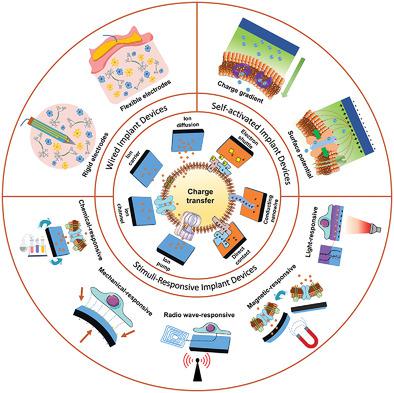Our official English website, www.x-mol.net, welcomes your feedback! (Note: you will need to create a separate account there.)
Biomedical Implants with Charge-Transfer Monitoring and Regulating Abilities
Advanced Science ( IF 15.1 ) Pub Date : 2021-06-24 , DOI: 10.1002/advs.202004393 Donghui Wang 1, 2 , Ji Tan 1 , Hongqin Zhu 1, 3 , Yongfeng Mei 3 , Xuanyong Liu 1, 4
Advanced Science ( IF 15.1 ) Pub Date : 2021-06-24 , DOI: 10.1002/advs.202004393 Donghui Wang 1, 2 , Ji Tan 1 , Hongqin Zhu 1, 3 , Yongfeng Mei 3 , Xuanyong Liu 1, 4
Affiliation

|
Transmembrane charge (ion/electron) transfer is essential for maintaining cellular homeostasis and is involved in many biological processes, from protein synthesis to embryonic development in organisms. Designing implant devices that can detect or regulate cellular transmembrane charge transfer is expected to sense and modulate the behaviors of host cells and tissues. Thus, charge transfer can be regarded as a bridge connecting living systems and human-made implantable devices. This review describes the mode and mechanism of charge transfer between organisms and nonliving materials, and summarizes the strategies to endow implants with charge-transfer regulating or monitoring abilities. Furthermore, three major charge-transfer controlling systems, including wired, self-activated, and stimuli-responsive biomedical implants, as well as the design principles and pivotal materials are systematically elaborated. The clinical challenges and the prospects for future development of these implant devices are also discussed.
中文翻译:

具有电荷转移监测和调节能力的生物医学植入物
跨膜电荷(离子/电子)转移对于维持细胞稳态至关重要,并参与许多生物过程,从蛋白质合成到生物体胚胎发育。设计能够检测或调节细胞跨膜电荷转移的植入装置有望感知和调节宿主细胞和组织的行为。因此,电荷转移可以被视为连接生命系统和人造植入设备的桥梁。该综述描述了生物体和非生命材料之间电荷转移的模式和机制,并总结了赋予植入物电荷转移调节或监测能力的策略。此外,系统地阐述了三种主要的电荷转移控制系统,包括有线、自激活和刺激响应生物医学植入物,以及设计原理和关键材料。还讨论了这些植入装置的临床挑战和未来发展的前景。
更新日期:2021-08-19
中文翻译:

具有电荷转移监测和调节能力的生物医学植入物
跨膜电荷(离子/电子)转移对于维持细胞稳态至关重要,并参与许多生物过程,从蛋白质合成到生物体胚胎发育。设计能够检测或调节细胞跨膜电荷转移的植入装置有望感知和调节宿主细胞和组织的行为。因此,电荷转移可以被视为连接生命系统和人造植入设备的桥梁。该综述描述了生物体和非生命材料之间电荷转移的模式和机制,并总结了赋予植入物电荷转移调节或监测能力的策略。此外,系统地阐述了三种主要的电荷转移控制系统,包括有线、自激活和刺激响应生物医学植入物,以及设计原理和关键材料。还讨论了这些植入装置的临床挑战和未来发展的前景。


























 京公网安备 11010802027423号
京公网安备 11010802027423号